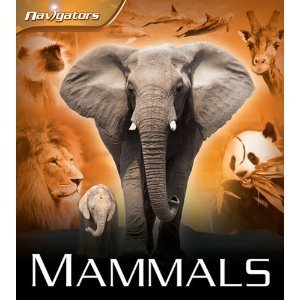MAMMALS
It's Nonfiction Monday at Capstone Connect. Check out all the great nonfiction posts.
MAMMALS
by David Burnie
Navigators Series
Grades 4 to 7
ISBN #978-0-7534-6610-0
Middle grade nonfiction
"The first mammals lived side by side with the dinosaurs, more than 200 million years ago. Dinosaurs died out, but mammals survived to become the most successful animals on Earth. They vary hugely in size and live on land, in water, and even in the air. But all mammals share three special features—they are warm-blooded, they have hair or fur, and they raise their young on milk."
Mammals begins with the definition of the characteristics that make a mammal, but it continues with so much more. Each spread of the 48 pages addresses the beginning of life through the varied ways of existence of a range of mammals and their characteristics specific to each group. The text on each spread addresses the specific information and includes fascinating sidebars about those mammals relating to the topic. The "Strength in Numbers" spread addresses rodents, but sidebars provide information about beavers, capybaras, rats, and ground squirrels. Small captions explain each of the numerous photographs and one quote relating to the topic is included.
"Follow the Leader" shows a herd of wildebeests across the Serengeti Plain while "A Better Bite" grabs the reader's attention with a huge photo of a mountain lion—tongue, teeth, and snarl. Comparative skulls illustrate different kinds of jaws and the teeth they contain. The book ends with "Mammals In Danger" and what is being done to preserve these mammal species.
Back matter includes a glossary, index, and suggestions for further investigation by the reader in museums, documentaries, and conservation groups. The photos are a mix of large and small and engaging as well as adding information to the narrative text.
This book will appeal to younger readers who may marvel at the photos and read to learn more as well as the middle grade reader who can pore over each mammal group with a mature looking book. It would be a good way to introduce mammals and their characteristics and provoke interest in the different mammal groups and characteristics. It's a fascinating book for elementary and middle school libraries.
Activity 1
Look up placental, marsupial, and monotremes in the mammal group. Develop a way to compare these different mammal groups and show why they are all mammals. Ideas may be shown using a PowerPoint presentation, an art project, or a classification chart.
Learn more about mammals here.
The San Diego Zoo site has excellent mammal information.
Activity 2
Investigate a selected mammal and find out specific adaptations the species has developed to aid in its survival.
This site has individual mammal information.
Here's more mammal information.
Activity 3
Look up endangered mammals and write an explanation of why that mammal is endangered and what is being done to protect that species.
Roberta at Wrapped in Foil suggested that the award-winning Can We Save the Tiger would be a good book to read for this activity.
Here's good information about endangered mammals.
Learn more about endangered mammals here.
National Science Standard: structures and processes; biological evolution
Book provided by Kingfisher








Shirley Smith Duke's Blog





